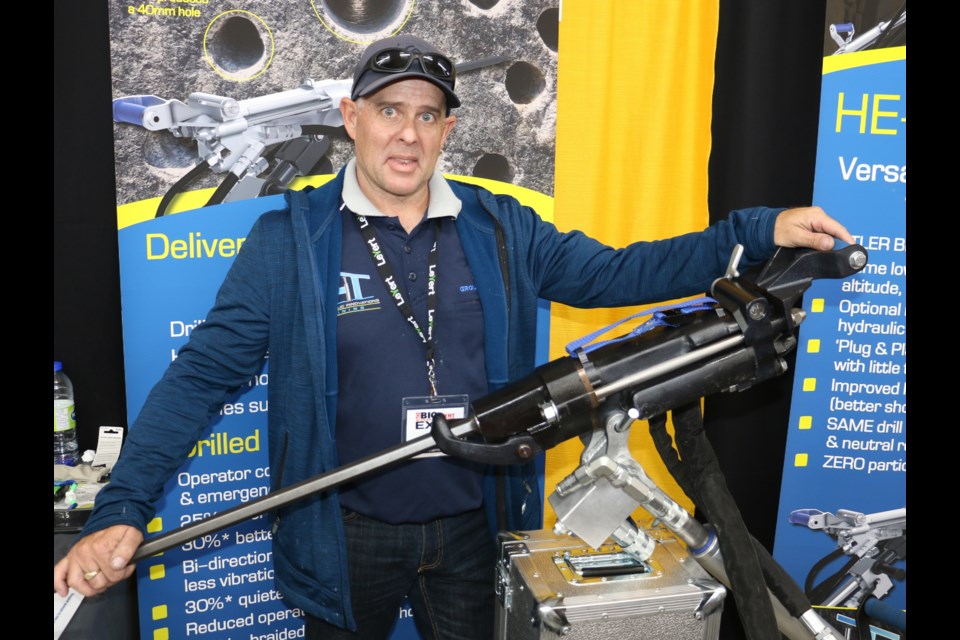One of the best-known pieces of machinery for underground mining might soon be undergoing a significant change. An Australian company is working to break into the Canadian market with a hydraulic-powered jackleg drill.
Kerry Scott the chief executive officer of Hydraulic Innovations Mining said his company is determined to change the dynamics of rock drilling with a safer and more cost-effective jackleg. He is also working to get a joint venture with a well-established Canadian firm based in Sudbury.
“We've got this all-oil hydraulic jackleg drill. It is revolutionary in the mining industry as far as utilizing a fully versatile one-person drilling system that you can use to go from jackleg operation to a rock breaker to jackhammer to vertical stoper, all with the one piece of equipment,” said Scott
The jackleg, a staple of the mining industry, has been around since the 1940s. It consists of an air-powered rotary rock drilling machine mounted atop an air-powered feeder leg that pushes the rock drill forward as the spinning steel and bit bites into the rock.
The conventional rock drill needs to have an air and water supply nearby. This is usually provided by a header, the combined air and water fittings that are attached to the steel air and water lines that run through every drift in the mine.
Scott said the old system is constrained by the need to install those air and water lines to power the drill. He said he believes the hydraulic drill is more efficient.
“This is a fit for purpose piece of equipment. You buy it and you're ready to go. You can run it from any hydraulic energy source,” he said.
“So basically a skid-steer machine, a scissor lift, an integrated tool carrier or even a small excavator. You just plug into their auxiliary port and you're off to work.
“Or you can choose to use one our custom-built power packs. We have this hydraulic power pack capable of producing 3,000 PSI. So they can be a multi-tool as well,” he continued.
Scott said the mobile power pack, weighing in at 570 kilograms, can be adapted to several other pieces of machinery. But the hydraulic jackleg drill still needs a water source, something Scott said can be provided by a portable water tank.
He said aside from the significant power output of up to 2000 PSI for the leg, there is also an important safety consideration of not having oil-saturated compressed air spewing out of the drill exhaust.
A conventional drill must be attached to an air hose for power and a water hose for dust control. The air hose also needs a lubricator, an oil reservoir device that keeps the internal machinery of the drill lubricated. While it contributes to the efficiency of the drill, it also produces and oily mist in the tunnel.
Scott said the new hydraulic jack needs no lubricator and so that's a safety advantage.
“You don't have the contaminants created by compressed air; the excessive heat, the oil vapour that is generated in the environment; so yeah, there are numerous benefits going for hydraulic energy.”
Another benefit he said is when mining companies decide to expand or create a new drift, they can easily decide to go forward without installing air and water lines. Scott said this is significant at a time when many mines are looking to reduce the electrical cost associated with running air compressors.
“It was 30 to 35 years ago that the large-scale drilling equipment, jumbos and so on, they made the transition from pneumatic to hydraulic. So this is the last link in the chain that removes that inefficient energy source and those airborne contaminants.
So what about the wear and tear on machinery working in a Canadian hard rock mine?
“The drill is extremely robust. It is comparative to any air leg you can put it up against with no problem at all.”
Scott said the drill is made of heat-treated aluminum as is strong as it needs to be.
“So basically it is just as strong as any jackleg drill on the market, any pneumatic system.”
He said the next step is to find a way to manufacture and distribute the new drill in North America.
“We are in the final stage of development. We are commencing trials in Australia at the end of June. We are in discussions with Canun International, a Canadian company. We hope to establish a joint venture with them and commence testing in the Canadian market in the next six months,” he revealed.
Scott said the Sudbury-based Canun company is already well-established in the Canadian mining industry.
Scott said the Hydraulic Innovations drill is currently manufactured in Australia but the intention is to set up a plant in North America, and said the economic benefits are too obvious. He said shipping industrial products out of Australia to other mining jurisdictions would take two to three months on a ship at sea.



